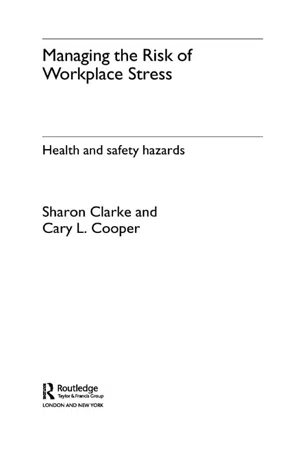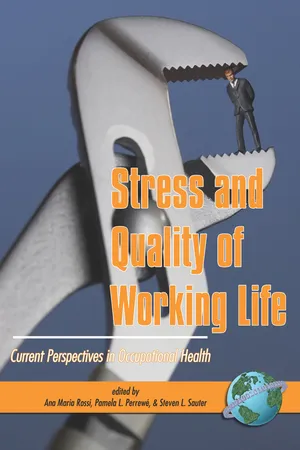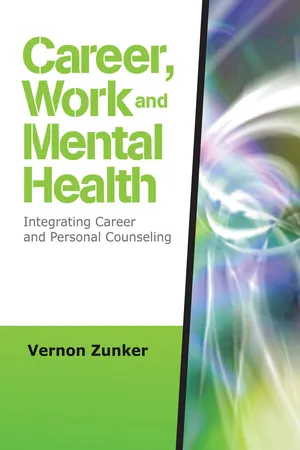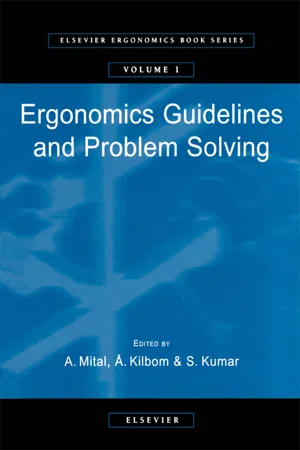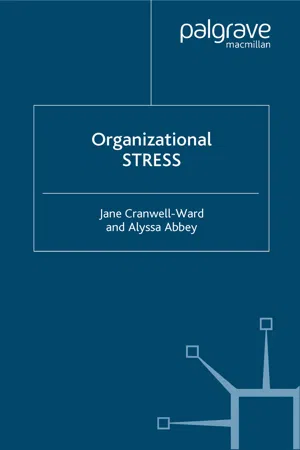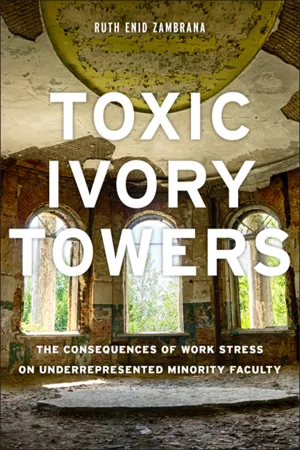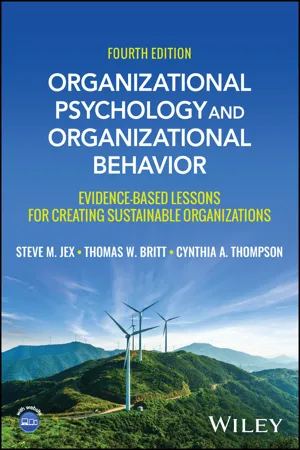Business
Effects of Work Stress
The effects of work stress can have a significant impact on employees and organizations, leading to decreased productivity, increased absenteeism, and higher turnover rates. It can also contribute to health issues such as anxiety, depression, and burnout. Addressing work stress through supportive management, clear communication, and promoting work-life balance can help mitigate these negative effects.
Written by Perlego with AI-assistance
Related key terms
1 of 5
12 Key excerpts on "Effects of Work Stress"
- eBook - ePub
Managing the Risk of Workplace Stress
Health and Safety Hazards
- Sharon Clarke, Cary Cooper(Authors)
- 2004(Publication Date)
- Routledge(Publisher)
Chapter 2
The effects of stress on employee-related outcomes
This chapter reviews research evidence of the effects of occupational stress on employee-related outcomes, including health and wellbeing, reduced productivity, absenteeism, turnover and work-related accidents. These stress outcomes are of particular relevance due to their practical implications for organisations. However, the behavioural symptoms of stress are studied far less frequently than psychological effects.Reviews of stress research distinguish between three major categories of strain: physiological, psychological and behavioural (Kahn and Byosiere 1992). A literature review conducted by Cooper et al. (2001) revealed that the measurement of physiological strain, such as cardiovascular, biochemical and gastrointestinal symptoms (Fried et al. 1984), was relatively rare, with the most common measures being blood pressure and heart rate. Self-report measures, utilising checklists of physical symptoms of health, were most popular, and research suggests that such measures are significantly related to a variety of work stressors, but relationships are relatively small (Jex and Beehr 1991). The type of physiological strain produced by an acute stressor may be quite different from that produced by chronic stressors (Fried et al. 1984). Research reviews indicate that psychological strains, such as job dissatisfaction and tension/anxiety, are strong correlates of work-related stressors (Jackson and Schuler 1985; Jex and Beehr 1991; Kahn and Byosiere 1992).As noted in the previous chapter, the research evidence to support the adverse effects that stress has on individual health is well documented (Cooper and Cartwright 1994; Cooper 1996). These negative effects include physical complaints and illnesses (Cooper and Payne 1988; Cooper and Watson 1991) and reduced mental health, such as nervous debility, tension headaches and mental breakdowns (Cartwright and Cooper 1997; see Table 2.1 - eBook - PDF
- Ana Maria Rossi, Pamela L. Perrewé, Steven L. Sauter(Authors)
- 2015(Publication Date)
- Information Age Publishing(Publisher)
As will be evident, we view employee effectiveness as much more than just “doing one’s job.” The fourth and final portion of the chapter explores the practical implications of research on workplace stress and employee effectiveness. STRESS IN THE WORKPLACE Before any discussion of the relationship between stress and effectiveness can begin, several terms need to be clarified. Inconsistent usage of the words stress and strain has been common across different research litera-tures (e.g., Beehr, Jex, & Ghosh, 2001; Jex, Beehr, & Roberts, 1992; McE-wen, 2000; Sapolsky, 1998; Sutherland & Cooper, 2002). In general, stress refers to an individual’s perception of a stressor , which is typically defined as conditions and/or events that result in strain (Kahn & Byosiere, 1992). In the short run, perceived stress can affect the attitudes and behaviors of an individual, but it is over a longer duration of time that these effects more frequently take on negative tones. This is the reason for the concept of strain , which refers to the consequences of stress over time (Beehr, 1995; Beehr & Newman, 1978). Stress and Employee Effectiveness 103 Sequentially, we view job stress as a process that can be viewed in terms of an expanded response-based model. - No longer available |Learn more
Career, Work, and Mental Health
Integrating Career and Personal Counseling
- Vernon Zunker(Author)
- 2008(Publication Date)
- SAGE Publications, Inc(Publisher)
Work Stress 195 11 W ork stress has been the topic of numerous research projects over sev-eral decades. The concerns surrounding work stress appear to be well founded. In 1999, for instance, it was estimated that 550 million work-ing days were lost annually in U.S. industries because of stress-related absen-teeism (Danna & Griffin, 1999). The pervasive nature of work-related stress may also be responsible for negative reactions to the workplace and/or to other employees and supervisors, and it has been known to promote poor job performance (Sulsky & Smith, 2005). In addition, health concerns such as gastrointestinal problems and cardiovascular disease have been associated with work stress, particularly shift work (G. Costa, 1996). Serious concerns over the health of the workforce have become a significant issue of the 21st century. In 1991, for example, almost 72% of workers in a national survey reported that they had experienced frequent stress-related problems (Muchinsky, 2003). Like the previous chapter, this chapter focuses on developing an under-standing of the interplay of influences that leads to symptoms of work stress. In the process of discovery helpers must recognize that many events in life can be stress related: First day in school, meeting new friends, prepping for an exam, and starting a new job are examples of stress-related events. The point here is that people face stress-related activities in almost all dimensions of their lifestyle; therefore, stress in the workplace consists of stressors that originate from multiple sources of experiences. Understanding the whole person as a member of a complex social system is a challenge for all helpers. In the pages that follow, however, the focus is on the work role, which for most individuals is a pervasive part of human existence. A person’s work role is often at the center of his or her life story. - eBook - ePub
- A. Mital, Å. Kilbom, S. Kumar(Authors)
- 2000(Publication Date)
- Elsevier Science(Publisher)
Similar findings are evident from other countries. In Australia, recent reports of stress claims for compensation (coded as mental distress) have showed marked increases in the rates for stress-related problems compared to those for other disabilities. For example, in a number of states, the workers’ compensation claims for stress nearly doubled over three years (Queensland Workers’ Compensation Board, 1990/91; Victorian Accident Compensation Commission, 1989/1990).2.2. Work-related measures
The scope of the problem can also be seen in effects on productivity and safety in addition to the effects of time-off work due to illness. There have been many reports that work performance can suffer due to work stress (Corlett and Richardson, 1981 ; Hockey, 1983 ), but it is much harder to quantify this effect than the effects of stress on health. It is generally acknowledged that productivity costs are much greater than health costs; however, it is often overlooked that there are two sources of effects of poor productivity. One is the indirect effect of poor health and the other is poor work performance resulting from the direct effect of stressors in the work environment. Some attempts have been made to quantify the former source. Matteson and Ivancevitch (1987) included the costs of absenteeism, extra employees to do the job of stress-affected employees, turnover and sabotage and estimated that these indirect aspects of work stress cost the US economy more than $300 billion per year.The impact of poor performance produced by stress is much harder to quantify outside individual workplaces. There are many studies of the effects of poor work environments on work performance. For example, studies show a positive relationship between high workload and error rates due to pressures on the individual’s capacity to perform (Kahneman, 1973 ; Wickens 1984 ). Many studies of work organisation have also shown that work performance can be improved by the way work is arranged (Gardell, 1987 - eBook - PDF
- Michael A. Hitt, C. Chet Miller, Adrienne Colella, Maria Triana(Authors)
- 2017(Publication Date)
- Wiley(Publisher)
High-involvement organizations require that asso- ciates be engaged and motivated to perform at high levels, and that their individual capa- bilities be used in the most productive and efficient manner. However, the consequences of work stress can sabotage managerial attempts to develop such an environment. The follow- ing discussion focuses on the individual and organizational consequences of stress. Individual Consequences Individual consequences of stress can be classified as psychological, behavioral, or physiological. Psychological Consequences Psychological responses to stress include anxiety, depression, low self-esteem, sleeplessness, frustration, family problems, and burnout. 80 Some of these psychological reactions are more severe than others. Their importance and overall effect on individual behavior and physical condition depend on their degree or level. Extreme frustration or anxiety can lead to other, more severe behavioral and physiological problems. One important psychological problem is burnout. Associates and managers experiencing burnout show little or no enthusiasm for their jobs, and generally experience constant fatigue. These individuals often complain bitterly about their work, blame others for mistakes, are increasingly absent from work, think about quitting their jobs, are uncooperative with co- workers, and become increasingly isolated. 81 Burnout often occurs in jobs that require individ- uals to work closely and intensely with others under emotionally charged conditions (nursing is an example). Burnout is a major concern in American industry and governmental organizations. Behavioral Consequences Behavioral consequences of stress include excessive smoking, substance abuse (alcohol, drugs), accident proneness, appetite disorders, and even violence. 82 Probably the most severe behavioral consequences are substance abuse and violence. Substance abuse, unfortunately, has become much more common in the United States in recent years. - Available until 5 Dec |Learn more
Organizational Psychology
A Scientist-Practitioner Approach
- Steve M. Jex, Thomas W. Britt(Authors)
- 2014(Publication Date)
- Wiley(Publisher)
Another indication of the harmful effects of occupational stress is the increasing trend toward stress-related workers' compensation claims (DeFrank & Ivancevich, 1998; National Council on Compensation Insurance, 1988 1991). In the past, compensation for work-related injuries was limited to physical injuries caused by some physical event or stimulus. Increasingly, however, more and more states are recognizing the legitimacy of physical and even psychological injuries that may be caused by some stressful aspect of the work environment that is not physical in nature (e.g., an overly demanding supervisor). In fact, a trend in recent research is to examine the intersection between psychological and physical risk factors in the prediction of both psychological outcomes (e.g., depression, burnout) and such physical outcomes as accidents (Kaplan & Tetrick, 2011).Occupational stress and employee health are also important because of their impact on society as a whole. It is unlikely that people experiencing constant stress on the job will function effectively in their other roles, such as husband/wife, parent, neighbor, and community member. Failure to perform these roles effectively may not have direct economic costs but may, in the long run, have a tremendously negative impact on society. Thus, occupational stress is clearly not the “cause of all societal ills,” but it does have an important and real impact on individuals, organizations, and society. Given the emphasis in this chapter on occupational stressors as predictors of health and well-being, it is worth highlighting that we view health and well-being in terms consistent with Jex, Swanson, and Grubb (2013). These authors highlighted that health and well-being should be considered as not only representing the absence of physical symptoms, but also the presence of positive psychological states and behavior.A Brief History
The earliest scientific investigations related to the field of occupational stress were conducted by the well-known physiologist Walter Cannon in the early part of the 20th century (e.g., Cannon, 1914). Cannon's work focused on the relationship between emotions and physiological responses, and is considered the earliest work in the field of psychosomatic medicine (the relationship between psychological states and physical illness). Cannon, however, is best known for having coined the term homeostasis - Terry Beehr(Author)
- 2014(Publication Date)
- Taylor & Francis(Publisher)
Part III Outcomes of stress in the workplaceOne of the necessary parts of the definition of occupational stress offered here consists of aversive outcomes to the individual — the strains. Organizational stressors lead to individuals’ strains and the first chapter of this section examines three types of strains: psychological strains, physical or physiological strains, and behavioral strains. These have not been studied and documented in equal proportion to each other in research from the organizational psychology point of view of job stress. The psychological strains have dominated research from this approach, probably because of a combination of researchers’ interests, researchers’ expertise, and the variables’ ease of measurement. The common thread in the fabric of these three strains is that they are deleterious to the individual experiencing them.The second chapter in this section of the book focuses on outcomes to the organization. These are not strains in the language used here and they are not by definition a necessary part of job stress. If they occur, however, they are important, albeit more so to the organization than to the individual. Outcomes of individuals’ stress to the organization could be either positive or negative, but past discussions in the literature have often either assumed or noted only the negative ones. Compared with the individual outcomes or strains, even less is known very clearly about the organizational outcomes of individuals’ occupational stress.Passage contains an image
Chapter 5 Individuals' strains Psychological, physiological, and behavioral effects of workplace stress
DOI: 10.4324/9781315795560-8The direct measurement of activation level will be difficult since students and employees alike will not be eager to have electrodes implanted in their brainstems.(Scott, 1966 : 25)By definition, occupational stressors lead to strains, at least for most people and under most conditions (Kahn and Byosiere, 1992- eBook - PDF
- J. Cranwell-Ward, A. Abbey(Authors)
- 2005(Publication Date)
- Palgrave Macmillan(Publisher)
ENVIRONMENTAL Work environments that are obviously noisy, chaotic, or potentially dangerous can easily be identified as a potential cause of stress. However, regular and unabated exposure to more mundane poor working conditions can also result in stress. For example, badly designed workstations present physical stresses to users who sit in front of computers for hours at a time. Guidelines provided by the HSE give employers information on how to carry out workstation assess- ments and educate employees on how they should be sitting and working. Taking responsibility for environmental issues and letting employees know what to do should they experience problems from their physical environment and then taking action minimizes the risk of employees experiencing this kind of stress. Some organizations may be large enough to fund health checks and provide cash towards eye tests; smaller companies can simply educate and elim- inate risk to keep problems to a minimum. Risk assessments should be carried out, as well as assessments of compe- tence in specific areas (for example driving) where individuals can be at risk. Clear record keeping and lines of responsibility are critical to maintaining an efficient process. Until the more high-profile cases of psychological stress came to the fore, employers focused most attention on being “compliant” with environmental legislation in terms of health and safety. The message now is that they have to achieve a balance with both the physical and psychological welfare of their employees. The Occupational Safety and Health Service (2003), in Wellington, New Zealand, carried out a comprehensive research program entitled Healthy Work: Managing Stress in the Workplace, which looked at managing stress and fatigue in the workplace. A key message that came out of its research was that the management of stress can be built into standard health and safety management systems and should involve employees. - eBook - PDF
Toxic Ivory Towers
The Consequences of Work Stress on Underrepresented Minority Faculty
- Ruth Enid Zambrana(Author)
- 2018(Publication Date)
- Rutgers University Press(Publisher)
Health outcomes of workplace stress can be physical, such as increased susceptibility to infections (Frone, Russell, & Barnes, 1996), or psychological, such as anxiety, burnout, and depression (Alamilla, Kim, & Lam, 2010; Sauter, Hurrell, Murphy, & Levi, 1997). These early signs of workplace stress are usually easy to recognize, but the effects of stress-inducing work roles on chronic conditions are more difficult to pinpoint as chronic diseases develop over the life span and are influenced by myriad factors. Nonetheless, evidence is rapidly accumulating to suggest that stress plays an important role in several types of chronic conditions—especially hypertension and cardiovascular disease progression (Wang et al., 2007; Webb & Gonzalez, 2006), musculoskeletal disorders, and psychological disorders (Israel, Baker, Goldenhar, Heaney, & Schurman et al., 1996; Lepore et al., 2006; McEwen & Kalia, 2010; NIOSH, 1997). Race-associated stressors contribute to racial/ ethnic inequities in health outcomes (Brondolo, Brady ver Halen, Pencille, Beatty, & Contrada, 2009; Mays et al., 2007; Williams & Williams-Morris, 2000). Prior scholarship has shown that the brain’s biological response to repeated acts of perceived discrimination and racism—whether real or perceived—raises an individual’s cortisol levels. Cortisol in low amounts helps control the body’s Workplace Stress 159 immune system but in large amounts can increase stress and the inflammation that causes heart disease, diabetes, infection, and obesity (Dedovic, Wadiwalla, Engert, & Pruessner, 2009; Kirschbaum, Bartussek, & Strasburger, 1992). As has been described throughout this book, discriminatory practices are an integral part of our respondents’ life course experiences and are strikingly acute in their higher education, graduate school, and faculty pathway. They experi- ence feelings of anger, frustration, doubt, guilt, or sadness when they encounter discrimination and microaggressions (Sue et al., 2008). - eBook - PDF
Coping with Work Stress
A Review and Critique
- Philip J. Dewe, Michael P. O'Driscoll, Cary Cooper(Authors)
- 2010(Publication Date)
- Wiley-Blackwell(Publisher)
International Journal of Stress Management 14(3): 227–48. Hauge, L. J., Skogstad, A. & Einarsen, S. (2007) Relationships between stressful work environments and bullying: Results of a large representative study. Work & Stress 21(3): 220–42. Haward, L. R. C. (1960) The subjective meaning of stress. British Journal of Psychol- ogy 33: 185–94. Hayman, A. (2008) Major job losses forecast for all of England. Regeneration & Renewal 7th November, http://www.regen.net/news/EmailThisArticle/ 859991/. Health & Safety Commission (2000) Securing Health Together: A long term occu- pational health strategy for England, Scotland and Wales. London: Health and Safety Executive. Health and Safety Executive (2005) Psychosocial Working Conditions in Great Britain 2005. London: HSE. Health and Safety Executive (2006) Stress-Related and Psychological Disorders. London: HSE. Health and Safety Executive (2007a) Violence at Work. London: HSE. Health and Safety Executive (2007b) Self-Reported Work-Related Illness and Work- place Injuries in 2005/06: Results from the Labour Force Survey. Caerphilly: HSE Information Services. Health and Safety Executive (2007c) Self-Reported Work-Related Illness or Work- place Injury. London: HSE. Heintzman, P. & Mannell, R. C. (2003) Spiritual functions of leisure and spiritual well-being: Coping with time pressure. Leisure Sciences 25: 207–30. References 173 Hemp, P. (2004) Presenteeism: At work – but out of it. Harvard Business Review 49–58. Hill, D., Lucy, D., Tyers, C. & James, L. (2007) What works at work? Review of evi- dence assessing the effectiveness of workplace interventions to prevent and manage common health problems. Leeds: Corporate Document Services, pp. 1–87. Hobfoll, S. E. (1989) Conservation of resources: A new attempt at conceptualizing stress. American Psychologist 44: 513–24. Hobfoll, S. E. (1998) Stress, Culture and Community: The psychology and philosophy of stress. - eBook - PDF
Organizational Psychology and Organizational Behavior
Evidence-based Lessons for Creating Sustainable Organizations
- Steve M. Jex, Thomas W. Britt, Cynthia A. Thompson, Cynthia A Thompson(Authors)
- 2024(Publication Date)
- Wiley(Publisher)
(2013). Work stress and health: A multidisciplinary review. Journal of Management, 39(5), 1085– 1122. doi:10.1177/0149206313475815 Ganster, D. C., Crain, T. L., & Brossoit, R. M. (2018). Physiological measurement in the organizational sciences: A review and rec- References 369 ommendations for future use. Annual Review of Organizational Psychology and Organizational Behavior, 5, 267–293. doi:10.1146/annurev- orgpsych-032117-104613 Gilboa, S., Shirom, A., Fried, Y., & Cooper, C. (2008). A meta-analysis of work demand stressors and job performance: Examining main and moderating effects. Personnel Psychology, 61(2), 227–271. https://doi-org. l i b p r o x y. c l e m s o n . e d u / 1 0 . 1 1 1 1 / j.1744-6570.2008.00113.x Goh, J., Pfeffer, J., & Zenios, S. A. (2019). The relationship between workplace stress- ors and mortality and health costs in the United States. Management Science, 62, 608–628. doi:10.1287/mnsc.2014.2115 Goh, J., Pfeffer, J., & Zenios, S. A. (2019). Reducing the health toll from U.S. workplace stress. Behavioral Science & Policy, 5(1), 1–15. Grandey, A. A. (2000). Emotional regulation in the workplace: A new way to conceptual- ize emotional labor. Journal of Occupational Health Psychology, 5(1), 95–110. Grandey, A. A., Fisk, G. M., & Steiner, D. D. (2005). Must “service with a smile” be stress- ful? The moderating role of personal control for American and French employees. Journal of Applied Psychology, 90(5), 893–904. Grandey, A., Foo, S., Groth, M., & Goodwin, R. E. (2012). Free to be you and me: A cli- mate of authenticity alleviates burnout from emotional labor. Journal of Occupational Health Psychology, 17(1), 1–14. Grant, A. M. (2007). Relational job design and the motivation to make a prosocial dif- ference. Academy of Management Review, 32(2), 393–417. Grawitch, M. J., Werth, P. M., Palmer, S. N., Erb, K. R., & Lavigne, K. - eBook - PDF
- Liu-Qin Yang, Russell Cropanzano, Catherine S. Daus, Vicente Martínez-Tur(Authors)
- 2020(Publication Date)
- Cambridge University Press(Publisher)
E. (2010). Psychological and physiological reactions to high workloads: Implications for well-being. Personnel Psychology , 63, 407–436, http://dx.doi.org/:10 .1111/j.1744–6570.2010.01175.x Jiang, L., & Lavaysse, L. M. (2018). Cognitive and affective job insecurity: A meta-analysis and a primary study. Journal of Management, 44, 2307–2342, http://dx.doi.org/:10.1177 /0149206318773853 Karasek, R. (1979). Job demands, job decision latitude, and mental strain: Implications for job redesign. Administrative Science Quarterly , 24, 285–306, http://dx.doi.org/:10.2307/2392498 Lang, J., Ochsmann, E., Kraus, T., & Lang, J. W. (2012). Psychosocial work stressors as antecedents of musculoskeletal problems: A systematic review and meta-analysis of stability-adjusted longitudinal studies. Social Science and Medicine, 75, 1163–1174, http://dx.doi.org/:10.1016/j .socscimed.2012.04.015 Lazarus, R. S. (1991). Progress on a cognitive– motivational–relational theory of emotion. American Psychologist, 46, 819–834, http://dx .doi.org/:10.1037/0003-066X.46.8.819 Lesener, T., Gusy, B., & Wolter, C. (2019). The job demands–resources model: A meta-analytic review of longitudinal studies. Work and Stress, 33, 76–103, http://dx.doi.org/:10.1080/02678373 .2018.1529065 Liang, L. H., Hanig, S., Evans, R., Brown, D. J., & Lian, H. (2018). Why is your boss making you sick? A longitudinal investigation modeling time-lagged relations between abusive supervision and employee physical health. Journal of Organizational Behavior, 39, 1050–1065, http://dx .doi.org/:10.1002/job.2248 Lin, S.-H., Scott, B. A., & Matta, F. K. (2018). The dark side of transformational leader behaviors for leaders themselves: A conservation of resources perspective. Academy of Management Journal, http://dx.doi.org/:10.5465/amj.2016.1255 Lin, W., Koopmann, J., & Wang, M. (2018). How does workplace helping behavior step up or slack off? Integrating enrichment-based and depletion-based perspectives.
Index pages curate the most relevant extracts from our library of academic textbooks. They’ve been created using an in-house natural language model (NLM), each adding context and meaning to key research topics.
